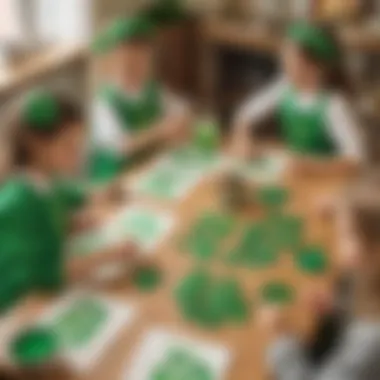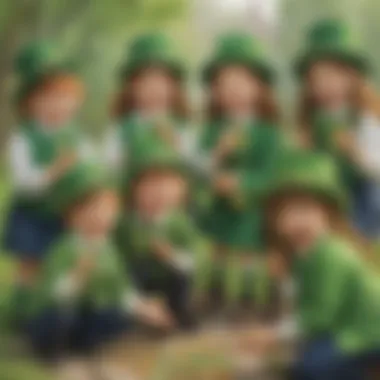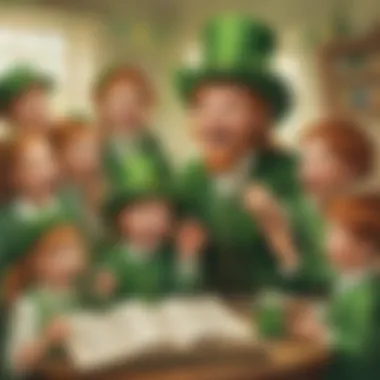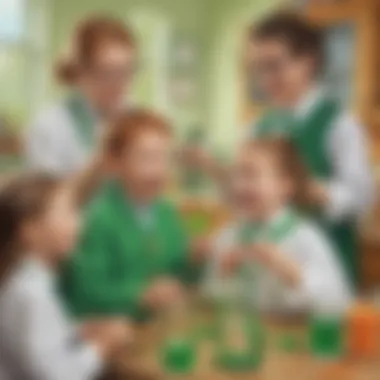Exciting St. Patrick's Day Activities for Kindergarten


Intro
St. Patrick’s Day is more than just a day for green attire and shamrock-themed snacks; it’s an opportunity to introduce young learners to cultural traditions and engaging activities that encourage creativity and teamwork. As kindergarteners begin to explore the world around them, St. Patrick's Day activities can serve as an exciting and educational catalyst for curiosity. Celebrating this festive holiday can offer an array of hands-on experiences that spark dialogue about history, art, and even science.
With a little creativity and a pinch of guidance, caregivers and educators can transform the day into a treasure trove of joy and excitement. It's not all about leprechauns or pots of gold, but the fun these little ones can have while learning something new.
Let’s take a closer look at how you can enrich kindergarteners' understanding of this holiday through well-thought-out activities, fostering a sense of community and curiosity along the way.
Science Fun Facts
When we think about St. Patrick’s Day, it might not immediately bring to mind science facts. However, there are plenty of fascinating elements about Ireland’s heritage and nature that can entice any little learner.
- Did You Know? Rainbows are often linked to the idea of a pot of gold at the end! While rainbows appear because of the refraction of light through water droplets, children can look forward to creating their own weather-related experiments.
- Shamrocks: These three-leafed plants are not only a symbol of Ireland but also have a rich botanical history. Teach children about their unique structure and how they differ from four-leaf clovers, believed to bring good luck.
"The shamrock is a symbol that connects us to our roots, helping us learn about nature and culture at the same time."
- Old Legends: St. Patrick is known for using the shamrock to explain the Holy Trinity. This can open up a discussion about how symbols convey deeper meanings in our lives.
Interactive Exploration
Incorporating trivia and storytelling can elevate children's understanding. Why not create a mini trivia game focused on Irish culture?
- Fun Facts about St. Patrick’s Day:
- It originated as a religious feast day in the 17th century.
- The color originally associated with St. Patrick was blue, not green!
By introducing these fun facts, children can bond over shared knowledge and learn through playful conversations.
Engaging Activities for Learning
The essence of St. Patrick’s Day can be felt in crafts and experiments that not only entertain but also educate. Here are a few hands-on ideas:
- Rainbow Art: Using colorful paints, have the children create their own rainbows. Discuss how colors blend to create new shades, sparking interest in color theory.
- Shamrock Science: Plant seeds in shamrock-shaped pots. As they grow, explore the life cycle of plants with the kids. Through this, children can learn about nurturing and the scientific method.
- Leprechaun Hunt: Set up a scavenger hunt around the classroom or playground, with clues that lead to learning about Irish folklore. Create a story about where the leprechaun might hide!
Involving children in activities that require them to think critically will serve them well in their educational journey.
Closure
When it comes to St. Patrick’s Day, the opportunities for learning and bonding through activities are endless. Each activity encourages children not just to use their imagination but to engage with significant cultural lessons. By integrating these engaging, educational activities into the classroom or home setting, we foster a sense of curiosity that can last a lifetime.
Celebrate with joy, and don't forget—each small step taken in learning brings about new discoveries and treasures!
Understanding St. Patrick's Day
To truly appreciate the significance of St. Patrick's Day, especially when introducing kindergarteners to its portrayal, it is vital to delve into its rich background, cultural implications, and the traditions that have become synonymous with the date. Understanding this holiday allows educators and parents to create learning experiences that are not only fun but also educational. By doing so, they lay the groundwork for inclusivity and respect for different cultures, fostering an environment of curiosity about the world.
Historical Background
St. Patrick's Day, observed on March 17th, is a celebration of the patron saint of Ireland, St. Patrick. Born in Roman Britain in the late 4th century, St. Patrick was captured by Irish pirates at age sixteen, later escaping back home. He eventually returned to Ireland as a missionary. One of the most notable legends associated with him involves using a three-leafed shamrock to explain the Christian Holy Trinity, which has forever tied the symbol of the shamrock to this holiday.
While originally a religious feast day, it evolved into a broader celebration of Irish culture. This transition began in the 18th century when Irish immigrants in the United States commemorated their heritage in a new land, leading to parades and festivities that showcase pride and community spirit.
Cultural Significance
The cultural weight of St. Patrick's Day lies not just in the legacy of St. Patrick himself but in what it represents today. This day has become a lens through which we can appreciate Irish heritage, exploring its influence on music, art, and food. It bridges communities across different backgrounds, allowing people to come together to celebrate not only Irish culture but also the little things that makes us humans.
For children, introducing the concept of cultural significance can inspire open-mindedness. Recognizing that there are diverse customs, traditions, and histories enriches their learning. By celebrating St. Patrick’s Day, they not only partake in the festivities but also learn to appreciate others' backgrounds.
Traditions Associated with the Day
Traditions linked with St. Patrick's Day are as colorful as the celebrations themselves. Here’s a glimpse into some popular customs:
- Wearing Green: People don green clothing and accessories in a show of solidarity with the Irish. It’s said that wearing green makes one invisible to leprechauns, who would pinch anyone they could see.
- Parades: Cities across the globe host parades featuring lively music, colorful floats, and local performers.
- Shamrocks: As mentioned, the shamrock is a prominent symbol. Many people decorate their homes with shamrock motifs, and they’re common in various activities and crafts.
- Traditional Food: Foods associated with the day may include Irish stew, corned beef and cabbage, and various green-themed snacks.
Incorporating these elements into classroom activities can make learning about St. Patrick's Day an engaging experience for kindergarteners. Through these traditions, they not only learn about the holiday but also the sense of community and celebration that comes with it.
"St. Patrick's Day fosters a unique opportunity to engage in conversations about culture, diversity, and celebration, essential for developing young minds."
By understanding St. Patrick's Day, educators can cultivate a richer context for various fun activities that teach children about the world around them.
Purpose of St. Patrick's Day Activities in Kindergarten
When we think about St. Patrick's Day, the first images that usually pop up are leprechauns, shamrocks, and everything green. However, beneath all the cheerful symbols, lies a chance to foster essential skills among kindergarteners. Engaging in various St. Patrick's Day activities provides a unique platform to not only celebrate the holiday but also encourage holistic development in young learners.


Promoting Cultural Awareness
One of the primary objectives of St. Patrick's Day activities is to promote cultural awareness among young children. At this tender age, kids are like sponges, soaking up every bit of information and experiences shared with them. By introducing them to the traditions and history behind St. Patrick's Day, we allow them to appreciate the richness of different cultures.
For example, telling stories of how the Irish celebrate this day can paint a vivid picture for children. You might share tales of parades in Irish towns, folk music that fills the air, and the special foods enjoyed during the festivities. This can spark their curiosity about the world, encouraging them to learn more about various cultures. Incorporating elements like traditional music or dance can further enhance their understanding, providing a hands-on experience that leaves a lasting impression.
Enhancing Social Skills
Activities centered around St. Patrick's Day are also fantastic for enhancing social skills among kindergarteners. When children come together to partake in group projects or games, they learn to communicate and collaborate. This collaboration is essential for their overall development, as it teaches lessons in empathy, sharing, and conflict resolution.
Engaging in activities like group crafts or team-based games fosters a sense of community and belonging. For instance, organizing a shamrock scavenger hunt can require children to work together, fostering unity. They learn to cheer each other on and value contributions from peers. Such experiences are stepping stones for forming friendships, helping them understand the value of teamwork from an early age.
Developing Creativity and Imagination
Lastly, St. Patrick's Day activities serve as a wonderful outlet for developing creativity and imagination among young learners. Allowing children to express themselves through art or storytelling can unlock their creative potential. Filling a classroom with vibrant colors indicative of the holiday can inspire children to create their own interpretations of the themes they encounter.
For instance, crafting leprechaun hats or creating rainbow art encourages children to think outside the box. As they cut, glue, and paint, they exercise fine motor skills while engaging their imaginations. In a way, these activities become a canvas for their thoughts, allowing them to explore different ideas and express themselves freely.
By celebrating St. Patrick's Day in kindergarten, we don’t just introduce a fun holiday to children but provide a platform for their personal growth, cultural understanding, and creative exploration.
In sum, the purpose of St. Patrick's Day activities reaches far beyond mere celebration. They serve as enriching tools, helping shape young minds while instilling a sense of joy and curiosity for learning.
Art and Craft Activities for St. Patrick's Day
Art and craft activities play a critical role in kindergarten environments, particularly on festive occasions like St. Patrick's Day. These activities encourage kids to express their creativity while simultaneously developing fine motor skills. Moreover, they provide young learners with an opportunity to explore their cultural heritage and understand the significance of the traditions behind the holiday. Through hands-on experiences, children not only create memorable projects but also deepen their connection to the vibrant stories and symbols associated with St. Patrick's Day.
Creating Leprechaun Hats
Making leprechaun hats can be a delightful venture for kindergarteners. This activity allows children to engage in a simple yet impactful craft that harnesses their imagination. To get started, gather materials such as green construction paper, scissors, glue, and some decorative items like stickers or markers. Children can trace and cut out a hat shape suitable for their heads.
Once they have their hats cut out, the real fun begins. They can decorate their hats using colorful embellishments. Perhaps they want to add a belt buckle made from shiny foil or include a rainbow sticker. This not only fires up their creativity but also makes them proud of their handiwork, which they can wear proudly during any celebrations.
DIY Shamrock Decorations
Crafting shamrock decorations is another engaging activity that aligns perfectly with the St. Patrick's Day theme. It’s a simple project that requires little more than green paper, scissors, and perhaps some string to hang the finished pieces. Young learners can cut out various sizes of shamrocks and then decorate them in any way they see fit—drawing patterns with crayons, glittering them up, or even painting them.
This activity provides insights into the symbolism of the shamrock as the national flower of Ireland. Discussing its meaning can spark curiosity and promote cultural awareness among children. They can hang their shamrock creations around the classroom, enriching the space with sprightly decorations that reflect the joyful spirit of the day.
Rainbow Collage Art
Rainbow collage art can open up a world of color for kindergarteners, allowing them to express their imagination while learning about the rainbow's connection to St. Patrick's Day. Begin by collecting materials like colored paper, magazine clippings, or any small craft items that shine. Ask each child to create their rendition of a rainbow on paper, which they can either draw or stick their colorful materials onto.
"The rainbow serves as a reminder of hope and joy, bringing in colors that brighten up even the gloomiest of days."
As they assemble their rainbows, this process can be integrated with stories about leprechauns hiding pots of gold at the end of rainbows. Connecting art to storytelling deepens their understanding of the cultural narratives and enhances their overall engagement. After the collage is completed, the artwork can be displayed around the classroom, showcasing their efforts and the lessons learned.
In essence, these art and craft activities not only enhance children’s creative skills but also foster a sense of community and collaboration as they share ideas and help each other in their projects. Each craft serves as a tangible reminder of their learning experiences during this festive celebration.
Educational Games for St. Patrick's Day
Engaging kindergarteners through games can be a powerful tool for learning, especially during festive occasions like St. Patrick's Day. The integration of educational games allows children to take part in fun activities while reinforcing key skills. Here are some important elements to consider regarding educational games:
- Skill Development: Games can aid in developing essential skills such as counting, matching, and teamwork.
- Cultural Understanding: They offer a unique platform for children to develop an appreciation for Irish culture and its rich traditions.
- Interactive Learning: This approach can captivate their attention, as most kids thrive in lively and interactive environments.
These educational games will arrive at the intersection of fun and learning, encouraging children to connect with the spirit of St. Patrick’s Day.
Counting Gold Coins
A classic element of St. Patrick's Day is the pot of gold at the end of the rainbow. By incorporating this imagery into a counting game, children can enhance their number skills while having a bit of fun. Here’s how to set it up:
- Materials Needed: Use plastic gold coins (or even paper ones) and a large pot or bowl to represent the pot of gold.
- Counting Activity: Scatter the gold coins around the classroom or outside. Have the children collect them in turns and practice counting them.
- Variations: After countin, you can turn it into a math problem by asking them to solve simple addition or subtraction using the coins.
This activity not only reinforces counting skills but also encourages teamwork, as children can help one another to find and count the coins.
Shamrock Scavenger Hunt
A scavenger hunt is an adventure on its own, but when you add the theme of St. Patrick’s Day, it becomes something special. Here’s how to organize a shamrock scavenger hunt:
- Preparation: Cut out shamrock shapes from green construction paper. Hide them around the classroom or outside.
- Instructions: Give the children a list of hints or riddles to solve, leading them to each shamrock. As they find them, they can check them off their list.
- Educational Twist: Once all shamrocks are found, gather the children to discuss the significance of the shamrock in Irish culture.
This activity not only ignites excitement but also builds problem-solving skills in a delightful way.
Matching Symbols and Traditions


Matching games are a fun-loving way to teach students about various Irish symbols associated with St. Patrick's Day. Here’s how to create your unique matching activity:
- Materials Needed: Cards that represent different symbols and traditions, such as leprechauns, shamrocks, pipes, and rainbows. Create two cards for each symbol.
- Game Setup: Mix them up and place them face down in a grid pattern.
- How to Play: Kids take turns flipping over two cards, trying to find matching pairs. When they successfully match a pair, they can share a fact about that symbol or tradition.
This activity not only helps develop memory skills but also fosters connections to cultural meanings behind each symbol.
In summary: Educational games for St. Patrick’s Day serve as an enriching approach to engage children in learning about culture, numbers, and teamwork while having a good time.
Interactive Storytelling for St. Patrick's Day
Interactive storytelling plays a crucial role in making St. Patrick's Day memorable for kindergarteners. It allows children to explore cultural narratives while engaging their imagination. Stories serve as a bridge to understanding traditions, connecting students to the Irish culture behind the holiday. Furthermore, this method cultivates listening skills, encourages verbal expression, and sparks creativity in young minds.
Reading Traditional Irish Tales
Diving into traditional Irish tales provides children a window into a world filled with fascinating characters and adventures. Stories like The Leprechaun’s Gold or The Tale of Finn McCool not only entertain but also impart lessons about bravery, friendship, and cleverness.
Finding a comfortable and bright space in the classroom can set the right mood. Teachers can use props, such as hats or small pots to engage the kids visually. Moreover, using finger puppets to act out characters allows students to step into the story. This hands-on approach captivates their attention and deepens their connection to Irish folklore.
Creating Group Stories
Group storytelling can be both fun and educational. It encourages collaborative play and builds communication skills among children. To start, the teacher can begin with a prompt related to St. Patrick’s Day, like "Imagine you found a pot of gold at the end of a rainbow!" Each child can then contribute an idea, weaving their thoughts into a collective tale.
This activates their imagination and helps them express ideas in a supportive environment. It’s valuable in showing that every voice matters, fostering a sense of belonging. Afterward, students can even illustrate key scenes from their story, combining their story with visual art.
Integrating Story Elements into Crafts
Integrating stories into crafts makes narrative exploration even more tangible. After reading a tale, children can be prompted to create their own craft based on what they learned. For example, if they heard about a leprechaun guarding his gold, they might create their own miniature pot of gold using clay or recycled materials.
Utilizing storytelling and crafts together elevates the learning experience. This hands-on activity helps solidify the children’s understanding of the story while tapping into their creativity. Furthermore, seeing their craft products displayed in the classroom nurtures pride in their work and encourages further participation in future storytelling sessions.
Culinary Activities for the Classroom
Culinary activities on St. Patrick's Day offer a delightful way to bring the festive spirit into the kindergarten classroom. Not only do these activities engage children in hands-on learning, but they also bridge cultural exploration with basic cooking skills. The act of preparing food is a multisensory experience—children can see, smell, touch, and taste, which makes learning memorable.
Additionally, these activities promote cooperation among classmates. As children work together to create foods, they practice important social skills like sharing, taking turns, and following instructions. This collaborative spirit mirrors the community essence of St. Patrick's Day, reminding children of the joy that comes from teamwork. Culinary activities also provide an opportunity to discuss ingredients, nutrition, and the significance of traditional Irish foods, enriching children’s understanding of the day’s celebrations.
Making Green Snacks
Creating green snacks can be a playful and healthy way to celebrate St. Patrick’s Day. It draws children's interest with bright colors, promoting curiosity about food and nutrition. To get started, gather some simple ingredients like green apples, cucumbers, spinach, or even green food coloring to customize snacks. Here are a few ideas:
- Green Apple Slices with Dip: Arrange sliced green apples on a plate and pair them with a yogurt dip. Kids can have fun dipping, and it teaches them about healthy eating.
- Spinach Smoothies: Blend spinach with banana, some yogurt, and a splash of orange juice. Kids will be surprised to see that a green drink can taste so sweet!
- Cucumber Sandwiches: Use whole grain bread, cut in shapes using cookie cutters, and add slices of cucumber to create delicious, bite-sized sandwiches.
Encouraging children to help with preparation, from washing ingredients to assembling their snacks, hones fine motor skills and boosts confidence. Plus, they’ll love enjoying something they made themselves!
Baking Irish Soda Bread
Baking Irish soda bread in the classroom can be much more than just cooking; it becomes an educational journey. This traditional Irish bread is simple enough for young hands, yet it introduces kids to the wonders of baking without requiring yeast, making it a quicker option. The basic ingredients typically include flour, baking soda, salt, and buttermilk.
Here’s a straightforward recipe to follow:
- Mix 4 cups of all-purpose flour, 1 teaspoon of baking soda, and 1 teaspoon of salt in a large bowl.
- Make a well in the center and gradually pour in 1 ½ cups of buttermilk while stirring with a wooden spoon until a dough forms.
- Knead the dough lightly on a floured surface for about 5 minutes. Shape into a round loaf.
- Cut a deep cross on top to allow the bread to rise evenly.
- Bake in a preheated oven at 425°F (220°C) for approximately 30 minutes or until golden brown.
Kids can take turns measuring and mixing, which reinforces math skills and understanding of measurements. The smell of freshly baked bread alone can bring joy and warmth to the classroom. Not to mention, when they taste their creation, it spices up the celebration and leaves them with feelings of accomplishment.
Incorporating culinary activities into the education process not only teaches essential life skills but also fosters a sense of community and cultural appreciation in young children.
By wrapping up the day with a feast of green snacks and warm soda bread, educators can ensure that St. Patrick’s Day is both fun and educational. Through simple yet meaningful culinary activities, children will learn not just about cooking, but about sharing, understanding traditions, and appreciating diversity.
Music and Movement Activities
In the realm of St. Patrick's Day celebrations for kindergarteners, music and movement activities play a crucial role, acting as a bridge between fun and education. These activities not only engage the young learners but also promote physical coordination, rhythm, and cultural appreciation. When it comes to processing information, children often learn better through active participation rather than passive listening. Thus, incorporating an energetic component helps them to internalize lessons in a joyful way.
While teaching about Irish culture, it is essential for educators and caregivers to acknowledge the significance of traditional Irish music and dance. These activities foster a sense of community and teamwork, as children often work together to learn dances and songs. When kids are moving, they're also improving their motor skills, a fundamental aspect of early childhood development. The heart of these activities lies in their ability to combine learning with laughter, creating an atmosphere where children feel safe to express themselves.
Learning Traditional Irish Dances
Traditional Irish dances are a delightful way to introduce kindergarteners to the rhythm and flow of Irish culture. Simple dances like the "Seannós" or simple line dances can be adapted for young children. Here are some points to consider:
- Simplicity is Key: Choose easy-to-follow dances that do not overwhelm young dancers. Keeping steps simple ensures every child can join in without feeling lost.
- Emphasize Joy Over Perfection: Focus on the enjoyment of movement rather than executing moves perfectly. Encourage natural expression through dance.
"Movement is a universal language. Through dance, children can communicate their excitement and engage with cultural traditions in a fun way."
Exploring Irish Music and Instruments
Bringing in traditional Irish music is a wonderful way to immerse kindergarteners in the themes of St. Patrick's Day. Learning about various instruments such as the tin whistle, bodhrán, and accordion can widen children's understanding of the musical landscape of Ireland. Here are a few activities to enhance their experiences:
- Instrument Exploration: Provide pictures of traditional Irish instruments. Discuss their sounds and uses. If possible, bring in actual instruments for children to touch and hear.
- Listening Sessions: Play recordings of lively Irish tunes, encouraging the children to move freely to the music. This helps them connect physical activity with auditory learning.
- Group Singing: Teach children simple Irish songs. Through this, they learn new vocabulary, improve memory skills, and enjoy collective harmony.


In closing, the integration of music and movement activities helps shape a richer understanding of St. Patrick's Day while keeping spirits high and bodies moving. By participating in these activities, kindergarteners not only celebrate the day but also enhance their overall development.
Incorporating Science into St. Patrick's Day
Involving science in celebrations like St. Patrick's Day can be a brilliant way to engage kindergarteners in learning, and this article highlights a couple of core activities built around that idea. When you blend fun seasonal themes with scientific principles, it not only captivates the young minds but also stirs their curiosity about the world around them. Kids naturally love exploring, and incorporating science into these joyful days can enhance their understanding of natural phenomena while enjoying the holiday spirit.
Rainbows and Light Refraction
Rainbows are like colorful bridges in the sky, and they can easily captivate a child’s imagination. The science behind rainbows is rooted in light refraction. This means that light bends as it passes through water droplets in the atmosphere, creating the beautiful colors we see.
One fun activity to introduce this concept is a simple experiment using a glass of water, a flashlight, and a white wall or piece of paper. Here’s how to do it:
- Fill a clear glass with water.
- Place it on the edge of a table, facing a wall or paper.
- Shine the flashlight through the glass at an angle.
- Observe the colors that appear on the wall.
Encourage children to discuss what they see. You can ask questions like:
- What colors do you notice?
- Can you see the rainbow shape? What makes it possible?
This whole endeavor not only reinforces science concepts but also promotes language skills as children express their observations.
"Experiments can make science come alive for kids—rainbows are not just pretty; they’re science in action!"
Plant Growth with Shamrocks
Shamrocks are more than just a symbol of St. Patrick’s Day; they are a fantastic way to teach kids about plant biology and growth. Engaging children in observing how plants grow can be both fun and educational. You can create a hands-on learning experience by involving them in growing their own shamrocks. Here’s a simple way to get started:
- Plant seeds: Get some shamrock seeds or use other fast-growing seeds for a quicker result.
- Water: Discuss the importance of water and how it helps plants grow.
- Light: Talk about sunlight and how plants need it to make food through photosynthesis.
- Observations: Ask children to keep a daily journal of their plant’s growth—note any changes they see.
This activity connects to nature, showing the kids how living things grow while also linking back to the holiday theme. Plus, it fosters responsibility and patience as they learn that growth takes time.
Implementing these activities during St. Patrick’s Day creates a delightful blend of cultural celebration and scientific exploration, giving kindergarteners a chance to learn while they have fun. Incorporating science into holiday activities can pave the way for a lifelong interest in exploring how the world works.
Assessment and Reflection
In the realm of early childhood education, the significance of assessment and reflection cannot be understated. Particularly for activities surrounding St. Patrick's Day, these elements serve as critical tools for educators and caregivers. They offer avenues to evaluate how well children engage with cultural nuances while simultaneously fostering an environment rich with creativity and learning.
When we discuss assessment in this context, it largely revolves around observing participation levels and determining what activities resonate with each child. It provides insights into their interests and learning preferences. Reflection goes hand-in-hand with assessment. It's the process of looking back and evaluating experiences, which can advance the planning of future activities. Together, they can aid in customizing learning experiences that are both fun and educational, ensuring that children grasp the significance of the holiday beyond just the festivities.
Tracking Participation and Engagement
One effective way to gauge understanding and engagement during St. Patrick's Day activities is by tracking participation. This means paying close attention not only to who is joining in but also to the enthusiasm and effort behind each effort. For instance, during a crafting session, note who is particularly invested in creating their leprechaun hats or shamrocks. Such observations are invaluable.
- Benefits of Tracking:
- Helps in identifying children's interests.
- Provides essential data to tailor future activities.
- Pinpoints skills that may need reinforcing.
This tracking doesn't have to be formal; it can be as simple as taking notes throughout the day or using a checklist. The goal is to create a picture of how each child is engaging with the materials and activities at hand.
Gathering Feedback from Students
Gathering feedback from students post-activities is just as crucial. It offers a window into their feelings about what they participated in. Children are often keen to express themselves, even when they might not have the vocabulary to do so. Simple methods, like asking open-ended questions or using visual aids, can yield significant insights.
Some approaches include:
- Discussion circles: Encourage children to share what they liked or didn’t like about the activities.
- Feedback stickers: Have various stickers representing different levels of enjoyment and let them choose.
- Reflection journals: For older kindergarteners, they might enjoy drawing what they created or experienced.
This feedback can be a goldmine for educators, allowing for refinement of activities that bring out the best in each child while honoring the spirit of St. Patrick's Day. An ongoing dialogue not only reinforces learning but also makes children feel valued and heard.
Final Thoughts
As we wrap up our exploration of St. Patrick's Day activities for kindergarten, it's essential to recognize the profound impact these activities can have on young learners. Celebrating St. Patrick's Day is not just about wearing green or nibbling on shamrock-shaped cookies; it's about immersing children in a vibrant cultural experience that promotes understanding and appreciation of diversity. This festive occasion is a perfect opportunity to introduce kindergarteners to new traditions, enhancing their social skills and creativeness while they engage in various fun activities.
Celebrating Diversity through Activities
Activities related to St. Patrick's Day provide an excellent platform for celebrating diversity. By exposing children to different cultural practices, they learn to appreciate variations that exist within their own communities and beyond.
- Storytelling: Reading traditional Irish tales not only entertains but also teaches children about moral values, folklore, and the richness of a different culture.
- Art Projects: Creating crafts like leprechaun hats or shamrock decorations allows children to express their creativity while learning the significance of these symbols.
"Understanding and embracing various cultures at a young age can pave the way for a more inclusive future."
Through these activities, children discover that while traditions may differ, the joy of celebrating through art, music, and food is universally shared. It's this sense of connection that fosters respect and empathy, qualities that will serve them well throughout their lives.
Encouraging Lifelong Learning
St. Patrick’s Day initiatives also encourage lifelong learning by sparking curiosity in young minds. Activities designed around this day can kickstart conversations about history, geography, and science, encouraging kids to explore further. For example:
- Science Exploration: Understanding how rainbows are formed through light refraction can lead to intriguing discussions about weather and space.
- Culinary Skills: Making traditional Irish foods can ignite interest in cooking, nutrition, and food science.
This enthusiasm for learning can manifest in various forms, whether it be seeking out more information on Irish history or wanting to learn about other cultural celebrations. The key is to create an environment where children feel comfortable exploring and asking questions.







